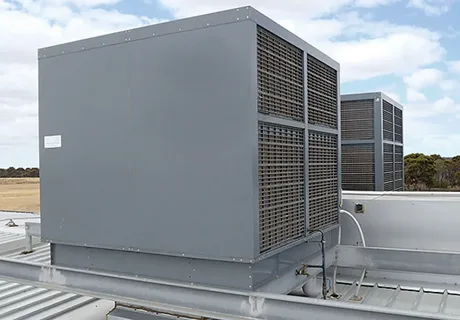
Introduction: Cooling Solutions for Manufacturing Challenges
Factories are stressful when it comes to cooling, both in terms of worker heat stress, as well as in terms of increasing energy prices. The correct system, i.e., either traditional HVAC or evaporative coolers and HVAC, may create a profound effect on the efficiency of operations, safety of employees and profitability. The production of cooling systems should meet the demands of large areas, machinery heating, and other regulations at reasonable prices.
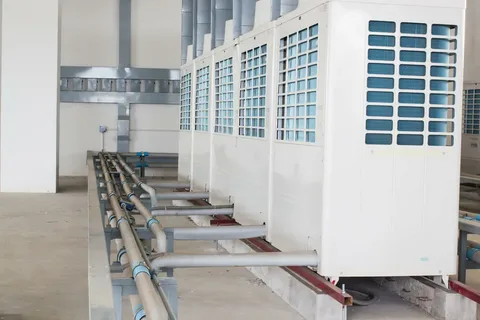
This paper will compare evaporative coolers and HVAC systems in terms of price, performance, airflow and ROI. We will assist factory managers in choosing the best system to fit their needs and requirements, be it ventilation of their factories or sustainability through examples in the industry and data insights.
The Cooling Challenge in Manufacturing Plants
The manufacturing plants are special places with high ceilings, massive floors, and machinery that generates heat, and thus cooling is essential. OSHA recommended workplace temperatures exceeding 30o C (86o F) because this heightens the risk of heat stress, which qualifies productivity and elevates the absenteeism. According to the data provided by the U.S. Department of Energy (DOE), cooling takes up 20-30% of the energy expenses in an industrial environment, which can be a burden to large-scale facilities.
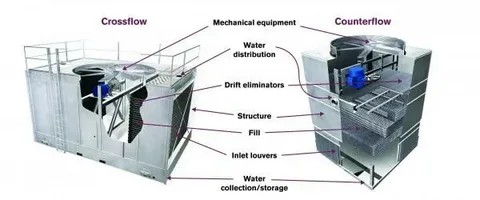
Ventilation of the factory should also be provided to meet the standards of ISO and OSHA to provide security to the workers and equipments. This is because it is difficult to strike a balance of costs, cooling power, and air quality without affecting the operations.
How Traditional HVAC Works in Factories
Conventional HVACs comprise compressors, condensers, and ducting to cool air by a refrigeration mechanism. Major features are:
- Strengths:
- Exact temperature regulation (e.g. keep 22 0 C/72 0 F in partitions).
- Performance throughout the year in all climates, even in humid areas.
- Appropriate to sensitive production (e.g., electronics, pharmaceuticals).
- Weaknesses:
- Heavy energy usage (1.2-1.5 kW/ton, according to ASHRAE).
- Complex configuration which involves plenty of ductwork.
- Expensive servicing (filters, refrigerants, professional servicing).
HVAC systems are cost-efficient and are frequently unnecessary when dealing with large and open manufacturing facilities because these systems are costly and provide unmatched advantages.
How Evaporative Coolers Work
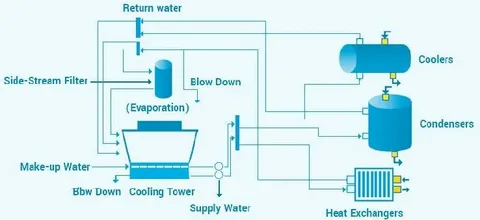
Evaporative cooling system is the cooling system based on the evaporation of water that reduces the temperature of air and pulls hot air through pads that are moistened with water and circulates cool, fresh air by using fans. Benefits include:
- Energy Efficiency: Use 70% to 80% of the energy that HVAC uses (0.3-0.4 kW/ton), according to DOE.
- Better Ventilation: Provide fresh, filtered, air all the time, eliminating stuffiness and smell.
- Reduced Costs: The reduced costs are due to less complex installation and less mechanical components, which lowers initial and maintenance costs.
- Limitations: It works best in dry to moderately humid conditions (humidity lower than 50%); in areas with high humidity; its efficiency is lower.
Large factories that are interested in cost-effective and environment-friendly solutions should use industrial evaporative cooling.
Cost & Performance Comparison
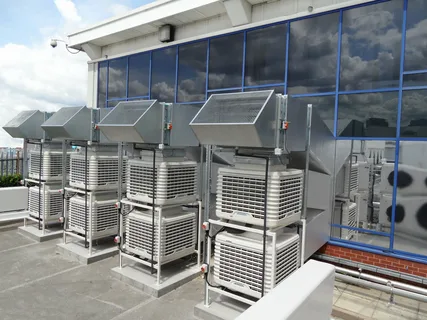
Energy Consumption & Operating Costs
- HVAC: Intensive consumption of electricity, particularly high in large plants. A 50,000-square-foot manufacturing facility with a 50-ton HVAC system has 6075 kW/hour which costs 30000-50000 a year at 0.15/kWh.
- Evaporative Coolers: consume 15-20 kW/hour of similar areas, at a price of 7,500-12,000/year, with a reduction of 60-75 of the energy bills, according to ASHRAE standards.
Cooling Effectiveness & Comfort
- HVAC: Maintains the same temperatures but also provides cold spots near the vents in large and open areas, leaving certain areas without cooling.
- Evaporative Coolers: Provide high-volume, uniform air-flow (e.g., 20,000 30,000 CFM in a mid-size plant), with a drop of between 15 and 25 o C and better ventilation in the factory.
Installation & Maintenance Costs
- HVAC: CAPEX is high (50,000 to 150,000 on a 50,000 sq ft building) because of ductwork and compressors. Maintenance costs 2,000-5,000/per year (refrigerants, filter replacement, etc)
- Evaporative Coolers: Reduce CAPEX (15,000-40,000) and minimal infrastructure. Maintenance is estimated to be 500-1500/ year pad cleaning, water system checks.
ROI & Payback Period
- Evaporative Coolers: Payback in 1 -3 years because of energy savings and reduced cost of installation. E.g. a savings of 20,000/annum of a 30,000 system would be evenly paid after 1.5 years.
- HVAC: ROI will be longer (57 years), as it is expensive due to the upfront and operating cost, but it is applicable to industries that need precision.
Case Studies & Industry Examples
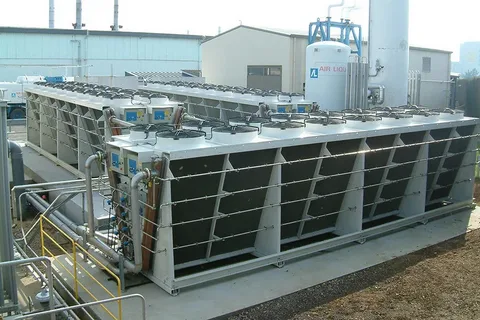
Case Study 1: Automotive Factory in Nevada
- Problem: A 100,000-square-foot car parts manufacturing plant spent more than 60,000 each year on HVAC and employee complaints regarding uneven cooling.
- Solution: Half the HVAC capacity was replaced with 12 evaporative coolers installed (25000 CFM each).
- Outcomes: 30% energy savings ( 18, 000/year), interior temperature dropped by 8C and worker productivity improved 12, according to internal surveys.
- Testimonial: The evaporative coolers changed our shop floor. Employees feel more content, and we are saving our thousands monthly. – Plant Manager
Case Study 2: Textile Plant in California
- Problem: One of the problems was a 75,000-square-foot textile plant experiencing dry air due to HVAC which impacted fabric quality and comfort among workers.
- Resolution: Installed evaporative coolers to bring in some degree of humidity and cool down large production spaces.
- Results: Saved 25% of energy value in terms of dollar (12,000/year), even humidity to handle fabrics and ten percent less absenteeism.
- Testimonial: The fresh air and humidity control was tremendous to our operations and staff. – Operations Supervisor
These examples underscore the usefulness of HVAC options to factories to enhance productivity and human health.
When to Choose Evaporative vs HVAC

Evaporative Coolers are suitable in:
- Big open manufacturing plants that are high-ceiling.
- Plants in hot dry locations (e.g. Southwest U.S. Middle East).
- Companies focus on the manufacturing of cooling aimed at energy efficiency and low prices.
HVAC Systems are better for:
- Industries that demand an accurate temperature regulation (e.g., electronics, pharmaceuticals).
- Wet weather conditions with low evaporative cooling power.
- Strict environmental facilities of sensitive products.
Hybrid Approach: HVAC is applied in sensitive areas of plants (e.g. clean rooms) and evaporative cooling in general areas, aiming at precision and cost efficiency. An example is a hybrid design in a Texas plant which would save 20 percent in cooling and achieve ISO standards.
Conclusion
The choice between evaporative coolers and the HVAC in the manufacturing plants is based on priorities: the evaporative coolers provide more economical cooling manufacturing, using less energy by 60-75 percent of the energy production and providing fresh and high-volume air change to enhance factory ventilation. HVAC offers more accurate control but is more expensive, which is why it can be applied to specific tasks. Evaporative cooling has provided a better ROI and more sustainable future to most of the factories.
Research KoolAir industrial evaporative cooling system to be used in manufacturing plants. Order a free airflow analysis today to reduce expenses and enhance the comfort of the workers.
FAQ
How much energy do evaporative coolers save vs HVAC in factories?
DOE data finds that evaporative coolers save 70-80% of energy consumed by HVAC systems which saved 15,000-30,000 a year in a 50,000 square foot establishment.
Do evaporative coolers work in humid climates?
They do not work so well in humid climates (>50%) but can be used with HVAC in hybrid systems to achieve balanced performance.
What is the payback period for evaporative cooling in manufacturing?
Average of 1-3 years, based on energy savings and costs of installation, which is contrasted with 5-7 years of HVAC systems.
